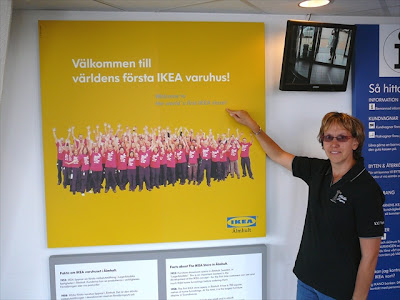 We left Gotheburg bright and early on the Monday (well, okay it was 9:30) ready for our visit to IKEA. Little did we know that just getting there was going to be as much of an experience as being there. We had decided to save some money on the train tickets so we didn’t get reserved seating. This was how we had travelled around Scandinavia and so far it had worked well, but not so well today. The train was crowded and we ended up moving seats about three times (no easy feat when you consider the amount of luggage we were hauling).
We left Gotheburg bright and early on the Monday (well, okay it was 9:30) ready for our visit to IKEA. Little did we know that just getting there was going to be as much of an experience as being there. We had decided to save some money on the train tickets so we didn’t get reserved seating. This was how we had travelled around Scandinavia and so far it had worked well, but not so well today. The train was crowded and we ended up moving seats about three times (no easy feat when you consider the amount of luggage we were hauling).If that wasn’t challenging enough, our train was running late and I started to get concerned about making the connection in Halmstad. I even asked the conductor, as we were getting closer to the station, if we would be alright - would the train wait? He assured me that we would be fine and maybe we would have, if we had known where we were going when we arrived at the station. We had to catch our connecting train two platforms over which meant going up some stairs, through the pedway, back down the stairs (did I mention we were really loaded down with luggage?) and down the platform to where the train was waiting. It was a relief to see our train still there until we noticed the conductor getting back on board, then the train started to move. We ran down the platform, waving our arms frantically, only to see it pick up speed and move right past us. This was the one time I saw Dennis really angry, I was glad I wasn’t the person at the ticket office. It wasn’t so bad though. They extended our tickets so we could catch the next train which would be in an hour. This just gave us a little more downtime than expected.
In due time, we arrived at Älmhult. We discovered that, unlike most train stations, there were no lockers for storing luggage at this station. However, the people at the ticket office graciously allowed us to leave it there so it wasn’t an issue after all.
After a short walk we arrived at the IKEA complex. I have to admit I was a little disappointed with the flagship store - except for a sign in the entryway, it looked like every other IKEA I‘ve ever been in. However, I did pick up a Dala horse baking pan and I’m not sure you’d find that anywhere else.
When I called it a complex earlier I wasn’t kidding. To get to the store itself we walked by a couple of big warehouses and across the parking lot we saw the IKEA hotel and restaurant. I wondered if it was furnished entirely with IKEA product. In lower level of the hotel was an IKEA museum. After we finished shopping, we decided to have a look through it and see what would be there. We arrived just before 3:00 (which was the closing time) but the staff there encouraged us to go through anyway and to take as much time as we wanted. It was basically a history of IKEA (as expected) and had rooms set up with furniture from the different decades - similar to how the stores have their demonstration rooms. We also received a book talking about the life of Ingvar Kampar and the evolution of IKEA. The book was actually written as an internal training tool for new employees so gave a fascinating glimpse into the whole philosophy. Just as an aside - that’s how he came up with the name IKEA - Ingvar Kampar Elmtaryd (family farm) Agunnaryd (home parish)
After leaving IKEA, we spent a little time looking around the town square (bought a Dala horse for myself and a few more things for the kids) then got back on the train and headed for Copenhagen.
In Copenhagen we had booked a CabInn hotel about 5 blocks from the train station so once we got our bearings (or rather once Dennis got his bearings since I’m directionally-challenged) we set off to find it. Once there, we discovered that this room was probably the smallest and least luxurious of any we had stayed in yet - really brought definition to the term ship-shape. I’m pretty sure it was even more compact than our ship cabin, even had bunk beds. Oh well, we had decided while planning the trip that hotel rooms were only a place to lay our heads at the end of the day so this fit that purpose.
After a nice supper at an Italian restaurant (Vesusius in Copenhagen, go figure!) we wandered around the area for a little. We saw a few shops that we pegged for visiting the next day (to hopefully fulfill the quest for a Danish vimple). We also saw a pair of buskers dressed as Native Americans (the full headdress and everything) but their music was nothing like I was expecting - mostly pan flutes, the Sound of Silence, that type of thing. Oh well, they certainly drew a crowd and I guess that was the point.
It had been a long day so we went back to our little hotel room (Dennis opted to sleep on the pull-out bed rather than the top bunk) and prepared to rest up for whatever adventure the next day might hold.
In due time, we arrived at Älmhult. We discovered that, unlike most train stations, there were no lockers for storing luggage at this station. However, the people at the ticket office graciously allowed us to leave it there so it wasn’t an issue after all.
After a short walk we arrived at the IKEA complex. I have to admit I was a little disappointed with the flagship store - except for a sign in the entryway, it looked like every other IKEA I‘ve ever been in. However, I did pick up a Dala horse baking pan and I’m not sure you’d find that anywhere else.
When I called it a complex earlier I wasn’t kidding. To get to the store itself we walked by a couple of big warehouses and across the parking lot we saw the IKEA hotel and restaurant. I wondered if it was furnished entirely with IKEA product. In lower level of the hotel was an IKEA museum. After we finished shopping, we decided to have a look through it and see what would be there. We arrived just before 3:00 (which was the closing time) but the staff there encouraged us to go through anyway and to take as much time as we wanted. It was basically a history of IKEA (as expected) and had rooms set up with furniture from the different decades - similar to how the stores have their demonstration rooms. We also received a book talking about the life of Ingvar Kampar and the evolution of IKEA. The book was actually written as an internal training tool for new employees so gave a fascinating glimpse into the whole philosophy. Just as an aside - that’s how he came up with the name IKEA - Ingvar Kampar Elmtaryd (family farm) Agunnaryd (home parish)
After leaving IKEA, we spent a little time looking around the town square (bought a Dala horse for myself and a few more things for the kids) then got back on the train and headed for Copenhagen.
In Copenhagen we had booked a CabInn hotel about 5 blocks from the train station so once we got our bearings (or rather once Dennis got his bearings since I’m directionally-challenged) we set off to find it. Once there, we discovered that this room was probably the smallest and least luxurious of any we had stayed in yet - really brought definition to the term ship-shape. I’m pretty sure it was even more compact than our ship cabin, even had bunk beds. Oh well, we had decided while planning the trip that hotel rooms were only a place to lay our heads at the end of the day so this fit that purpose.
After a nice supper at an Italian restaurant (Vesusius in Copenhagen, go figure!) we wandered around the area for a little. We saw a few shops that we pegged for visiting the next day (to hopefully fulfill the quest for a Danish vimple). We also saw a pair of buskers dressed as Native Americans (the full headdress and everything) but their music was nothing like I was expecting - mostly pan flutes, the Sound of Silence, that type of thing. Oh well, they certainly drew a crowd and I guess that was the point.
It had been a long day so we went back to our little hotel room (Dennis opted to sleep on the pull-out bed rather than the top bunk) and prepared to rest up for whatever adventure the next day might hold.
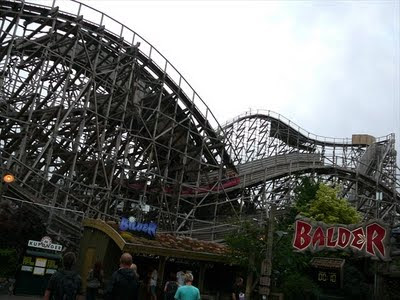
 We arrived at Hestra in the rain, good thing the bike rental idea had fallen through. When we got out of the taxi we saw some people down by the cow barn so started heading in that direction.
We arrived at Hestra in the rain, good thing the bike rental idea had fallen through. When we got out of the taxi we saw some people down by the cow barn so started heading in that direction.
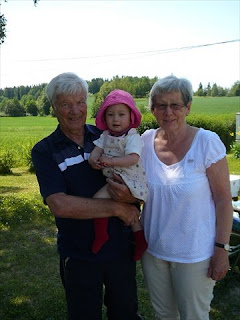 Saturday July 4 was another travelling day and a long one at that. This was our trip from Kolbu to Gotheburg via Oslo. In total I think we spent about 6 or so hours on the train - we’re sure getting good at organizing all our luggage and ourselves, especially when each country seems to have a different system of doing this.
Saturday July 4 was another travelling day and a long one at that. This was our trip from Kolbu to Gotheburg via Oslo. In total I think we spent about 6 or so hours on the train - we’re sure getting good at organizing all our luggage and ourselves, especially when each country seems to have a different system of doing this.

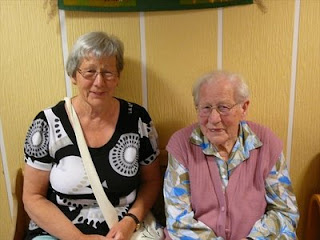 We must have been tired because once again we slept in (seems to be a recurring theme, time to think of going home). When we got up we had a nice breakfast with Kari, Magne and Roar; then it was time for Roar to leave - he was committed to providing some musical entertainment at the Senior’s Home where his mother now lives.
We must have been tired because once again we slept in (seems to be a recurring theme, time to think of going home). When we got up we had a nice breakfast with Kari, Magne and Roar; then it was time for Roar to leave - he was committed to providing some musical entertainment at the Senior’s Home where his mother now lives.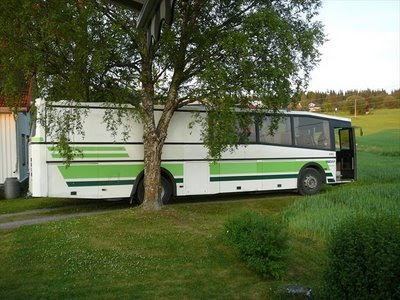 Now it was time for us to reconnect with my side of the family. I had made arrangements with a relative (also named Kari and married to a man named Magne, how confusing is that!) that we should spend some time with her at their farm near Kolbu, north of Oslo. Kari’s grandmother is a cousin of my grandfather (her mother is a first cousin of my mother, I’m not sure what that makes us.) We had met her when she was in Canada a few years ago and she had come to our house with my parents.
Now it was time for us to reconnect with my side of the family. I had made arrangements with a relative (also named Kari and married to a man named Magne, how confusing is that!) that we should spend some time with her at their farm near Kolbu, north of Oslo. Kari’s grandmother is a cousin of my grandfather (her mother is a first cousin of my mother, I’m not sure what that makes us.) We had met her when she was in Canada a few years ago and she had come to our house with my parents.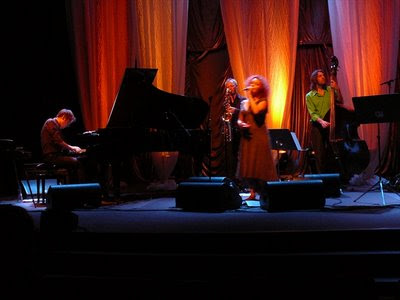
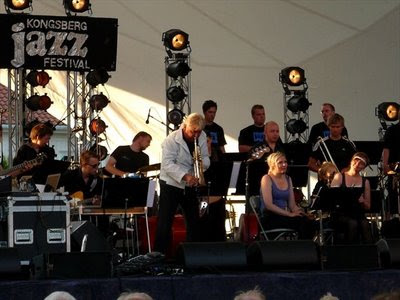
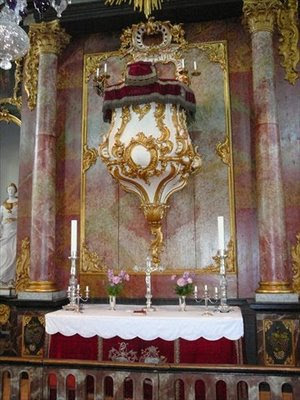 Wednesday July 1 we enjoyed our final breakfast at Per’s, following which Per played some music for us, first on his Hammond B3, and then on one of his accordions. He is an excellent musician, and we heard more evidence of this in the car on the way to Kongsberg as he played us a recording from a band he was part of. He also gave us a CD of his most recent recording and we look forward to being able to play it when we get back to Canada.
Wednesday July 1 we enjoyed our final breakfast at Per’s, following which Per played some music for us, first on his Hammond B3, and then on one of his accordions. He is an excellent musician, and we heard more evidence of this in the car on the way to Kongsberg as he played us a recording from a band he was part of. He also gave us a CD of his most recent recording and we look forward to being able to play it when we get back to Canada. Our tour around the Royse area (where the Nosterud farm is situated) continued with a trip to the Hole Church (not 'hole' as in a empty space, but a Norwegian named pronounced something like hol-la), which was rebuilt after a fire in the 40s. I think that this was the church my grandparents were married in (though none of the cousins could answer that for sure). The rebuilt church has a very modern design painted on the ceiling, certainly not what we expected when we first walked in. The over all look of the sanctuary was simple and uncluttered (very different from all the other churches we have visited in Europe), only some decorative items from the original church building that were rescued from fire (the altar piece for example) were more fancy in appearance.
Our tour around the Royse area (where the Nosterud farm is situated) continued with a trip to the Hole Church (not 'hole' as in a empty space, but a Norwegian named pronounced something like hol-la), which was rebuilt after a fire in the 40s. I think that this was the church my grandparents were married in (though none of the cousins could answer that for sure). The rebuilt church has a very modern design painted on the ceiling, certainly not what we expected when we first walked in. The over all look of the sanctuary was simple and uncluttered (very different from all the other churches we have visited in Europe), only some decorative items from the original church building that were rescued from fire (the altar piece for example) were more fancy in appearance.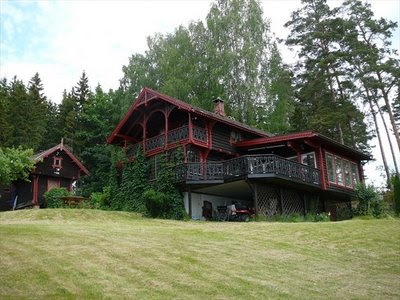
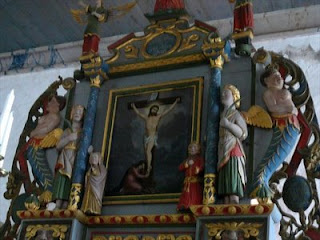 Tuesday morning, June 30th, we awoke to another beautiful day in Norway. After a nice breakfast at Per‘s we loaded into cars and went on a tour of the area. The first stop was the Bønsnes Kirke (Church). King Olav the Saint (995 to 1030 AD) was born near the site of the church and there is a tale that says it was built by the King himself (the tale says during a voyage on the Tyrifjord Lake he found his life in danger and he promised to build a church if he and his men would reach the shore alive). Olav is important in Norwegian history because he is the first King to establish what would become the modern borders of Norway, unifying the people (at least briefly) of the whole land. He is considered a saint because he brought Christianity to the interior and north of Norway, and after he died people claimed to be healed by his relics - thus began a long tradition of pilgrimages to Trondheim where Olav was buried. This Bønsnes Kirke was one of the stops on the pilgrimage journey.
Tuesday morning, June 30th, we awoke to another beautiful day in Norway. After a nice breakfast at Per‘s we loaded into cars and went on a tour of the area. The first stop was the Bønsnes Kirke (Church). King Olav the Saint (995 to 1030 AD) was born near the site of the church and there is a tale that says it was built by the King himself (the tale says during a voyage on the Tyrifjord Lake he found his life in danger and he promised to build a church if he and his men would reach the shore alive). Olav is important in Norwegian history because he is the first King to establish what would become the modern borders of Norway, unifying the people (at least briefly) of the whole land. He is considered a saint because he brought Christianity to the interior and north of Norway, and after he died people claimed to be healed by his relics - thus began a long tradition of pilgrimages to Trondheim where Olav was buried. This Bønsnes Kirke was one of the stops on the pilgrimage journey.

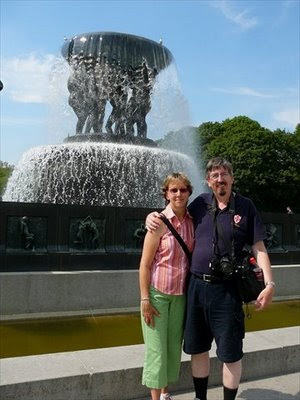 After the visit to Rainbow Studio we began a walking tour of Oslo with Kari Grande. We walked down the path by the river, going through the old textile mill area. The river was lovely, and the coolness that we felt walking beside the water and in the shade of the trees was welcome on a very hot day. There were some nice waterfalls and interesting buildings. Along the way Kari would give us bits of history, pointing out various monuments, buildings and sites.
After the visit to Rainbow Studio we began a walking tour of Oslo with Kari Grande. We walked down the path by the river, going through the old textile mill area. The river was lovely, and the coolness that we felt walking beside the water and in the shade of the trees was welcome on a very hot day. There were some nice waterfalls and interesting buildings. Along the way Kari would give us bits of history, pointing out various monuments, buildings and sites.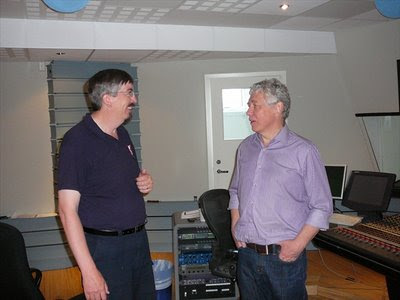
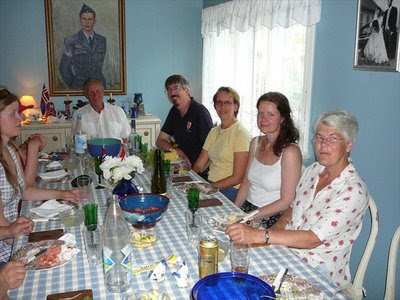

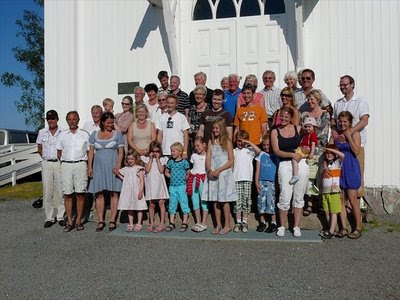
 Saturday June 27th started with a lovely breakfast, at which both of Sissel and Terje’s boys showed up. When I visited back in 1980 they were just boys with whom I enjoyed playing (being nothing more than a big boy at that stage anyways). Now they are grown men with families of their own. Leif is a dentist (with a practice in Oslo) who lives on the farm in the house I talked about in the previous post - he and his wife Tone have three children. Tryggve is a teacher and lives with his wife Kjersti and two children in Fetsund, about a 20 minute drive from the farm. Tryggve pulled into the yard in his sports car, and I found out that up until a couple of years ago he raced motorcycles (much to the concern of his mother).
Saturday June 27th started with a lovely breakfast, at which both of Sissel and Terje’s boys showed up. When I visited back in 1980 they were just boys with whom I enjoyed playing (being nothing more than a big boy at that stage anyways). Now they are grown men with families of their own. Leif is a dentist (with a practice in Oslo) who lives on the farm in the house I talked about in the previous post - he and his wife Tone have three children. Tryggve is a teacher and lives with his wife Kjersti and two children in Fetsund, about a 20 minute drive from the farm. Tryggve pulled into the yard in his sports car, and I found out that up until a couple of years ago he raced motorcycles (much to the concern of his mother).
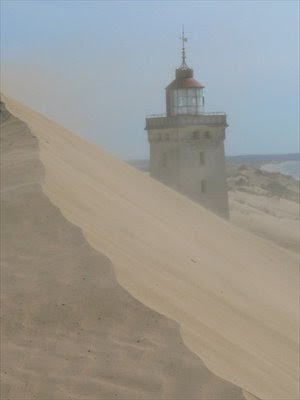 Thursday we left the Skjern area and this would be a crazy day - one in which we would try to use the public transportation system in a country we weren’t familiar with, to reach a remote area where part of Babette’s Feast was filmed. The day began well enough, with Jørn being able to give us a ride into the train station (rather than take a taxi), he was heading in to the last day of school (he is a science teacher) and so his work schedule worked out perfectly with our travel schedule.
Thursday we left the Skjern area and this would be a crazy day - one in which we would try to use the public transportation system in a country we weren’t familiar with, to reach a remote area where part of Babette’s Feast was filmed. The day began well enough, with Jørn being able to give us a ride into the train station (rather than take a taxi), he was heading in to the last day of school (he is a science teacher) and so his work schedule worked out perfectly with our travel schedule.